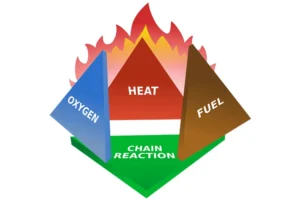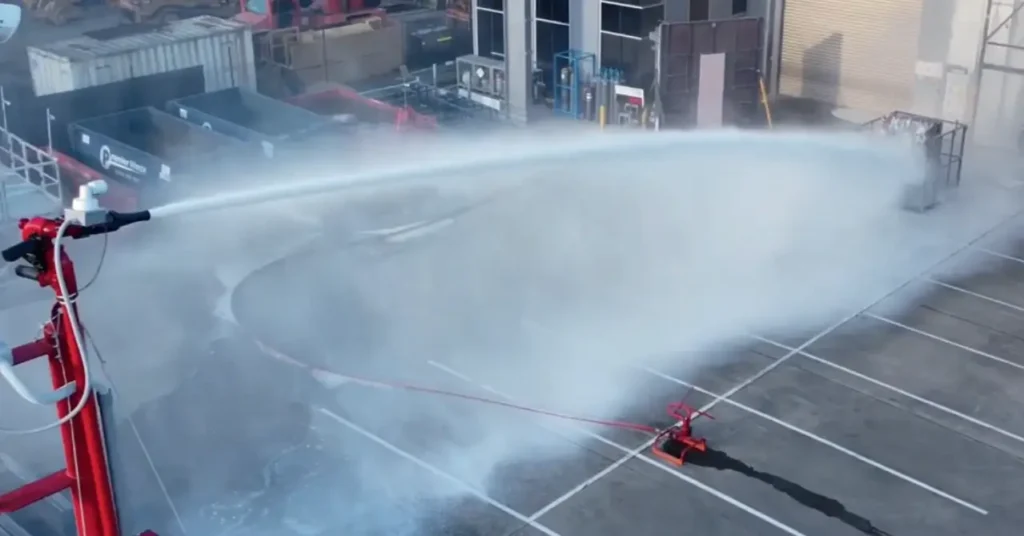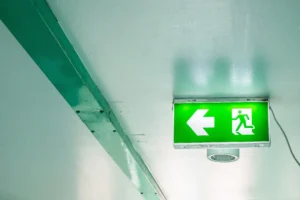
Preventing Fires through Effective Business Housekeeping
Understanding the science of the fire triangle—comprising heat, fuel, and oxygen—is essential for preventing fires. Here’s how to apply this knowledge to maintain a fire-safe workplace.
Book your FREE, no-strings-attached Fire Safety Audit to ensure that you’re properly protected from the risk and comply with current fire safety legislation.
Get essential insights and updates
in fire safety – straight to your inbox!

Lithium-ion batteries causing fires in the waste stream is a well-worn topic. However, now and then, you stumble across a piece of data, which makes you sit up and blink. Here are two of the most shocking examples I’ve encountered recently:
A recent test by Fisacon, burning an e-scooter battery. “During the test, battery parts flew around at about 300 metres/second. For comparison: a 9mm bullet reaches around 360 metres/ second. Anyone hit by a glowing battery cell can expect serious injuries.” That’s probably the most compelling reason I’ve heard why your site staff shouldn’t be tackling these fires themselves.
This data doesn’t cover the other batteries entering the waste stream, from greetings cards to EV batteries. It is a small wonder then that the recycling industry has a ‘fire problem’.
It’s no wonder, too, that insurers are taking a hard look at their risks in the recycling sector. One insurer told me that they had seen a tenfold increase in fire losses at recycling facilities over five years.
Thus, the familiar question arises: What can we do about it?
Good fire safety consists of layers of protection. There is no single ‘panacea’ solution which covers all scenarios.
Site/plant design and layout, stockpile management and housekeeping all play as much of a role as your fire detection and suppression systems.
However, investment in proper fire protection systems is also key. Trained site operators can often play a key role in ensuring a successful outcome from a fire incident – but they should never be your primary firefighting ‘asset’. There is a multitude of reasons for this, but here are two of the most pertinent:

Different risk areas (tipping/storage, shredders, conveyors, bunkers, etc.) require different types of detection and suppression, which we can’t cover in detail in this article. However, the tipping/storage area is one of the key risk areas common across most recycling plants.
For these areas (generally characterised by a dynamic storage layout, high-roof buildings, natural ventilation, high humidity and dust), the best form of protection is almost invariably achieved by using water cannons.
Our Fire Rover system utilises advanced forms of early detection and targeted use of water cannons to detect and suppress a fire before it has a chance of becoming established. Unique to the Fire Rover system are the three simple commitments we can make to our clients:
Automatic water cannon systems utilise various forms of fire detection. Fire Rover uses three systems: thermal, video smoke detection and flame detection. Each detection method complements the strengths and weaknesses of the others.
Each detection method is also prone to false alarms. After all:
Our unique approach utilises remote human verification of every single alarm that occurs on the system. Only confirmed and actionable events will ever be escalated to raise an alarm at your facility. This guarantees you a sensitive detection system with zero false alarms.
There are many ways to activate a target and spray a water cannon. That’s the easy part.
The hard part is doing so safely. What if a staff member is already trying to fight the fire? Or if an explosive incident results in multiple fires? Or if, in external conditions, a sidewind deflects the water spray?
Our unique approach is to target, activate and direct the cannon using our remote, highly trained human operator.
This brings three key benefits: an intelligent dynamic response to each incident, safety for your operators, and efficient use of fire fighting water rather than a programmed system’s ‘spray and pray’ approach.
These complex fire-fighting systems require regular maintenance and full system uptime.
We take away the headache of maintaining your fire system. That’s done for you. Any parts that fail? They’re covered under our catch-all warranty for the lifetime of the system.
We have a proven track record of success with over 600 Fire Rover installations globally (mainly in recycling facilities). In 2023 alone, Fire Rover remote operators extinguished 183 fires at clients’ facilities (with a 100% success rate).
Fires at recycling facilities are not going away any time soon. Even if we put batteries aside, there are plenty of other risks that end up in the recycling stream with improperly disposed gas canisters, solvents, or even just the mechanical risks associated with shredding.
Each area of your recycling process must be properly risk-assessed to find the correct fire protection solution. Generally, the correct fire protection solution for your facility will combine several systems for various risk areas.
Contact us at Blazequel today to discuss your facility and how we can help make your recycling facility safer!

Understanding the science of the fire triangle—comprising heat, fuel, and oxygen—is essential for preventing fires. Here’s how to apply this knowledge to maintain a fire-safe workplace.

Ensuring the safety of your premises goes beyond just fortifying against potential intruders; it’s equally crucial to prioritize ease of evacuation, particularly in today’s climate of heightened crime rates and

Fire safety is a critical concern in factories and warehouses due to the potential for significant harm to both individuals and assets. These environments often house flammable materials, heavy machinery,
Video Smoke Detection is perfect for a fast response to fires in high roofed buildings and harsh operating conditions.
Watch Smokecatcher detect smoke in an MSW storage building. The smoke is coming through from a fire in the adjoining storage area.
Watch Smokecatcher detect a fire in an SRF Storage bunker. Sadly, the alarm wasn’t responded to and the site lost a 4hr window of opportunity between smoke detection and flames appearing.
Video Smoke Detection overcomes the risks of stratification and other challenges for early fire detection in logistics and storage facilities.
Watch Fire Rover detect and suppress a fire in the waste bunker at an EFW facility!
See how the Fire Rover detects and suppresses this fire at a clients tipping hall. Note how the smok is spreading out at low leve, rather than rising. This is called ‘stratification’ and is one of the many reasons why roof-mounted smoke detection systems like beam detectors and HSSD is not suitable for many recycling applications.
Watch the Fire Rover detect and suppress a fire at a battery storage facility. This targeted and intellegent control makes the Fire Rover particularly well suited to high hazard storage applications.
Watch the Fire Rover tackle a battery fire in a tipping hall. Note how the exploding battery cells start three separate fires, which the operator individually suppresses (whilst avoiding the site operators in the vicinity).
Get essential insights and updates in fire safety – straight to your inbox!
